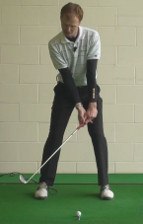
Thin Shot
A “thin shot” in golf refers to a shot where the golfer strikes the ball with the bottom edge or the center of the clubface, resulting in the ball being hit too low on the clubface. As a result, the ball may have a low trajectory and travel farther than intended or desired.
There are several factors that can cause a golfer to hit a thin shot:
- Incorrect setup: If a golfer positions the ball too far forward in their stance, it can cause the club to strike the ball in a thin manner. It is important to have the ball positioned correctly in relation to the clubface.
- Lack of posture: Poor posture during the setup can also contribute to hitting thin shots. Maintaining proper posture throughout the swing helps ensure a solid impact with the ball.
- Swing plane: If the golfer's swing plane is too steep, it can result in the clubhead descending too sharply and hitting the ball thin. Maintaining a proper swing plane is crucial to achieving consistent contact.
- Tension in the hands and arms: Gripping the club too tightly or having tense muscles in the hands and arms can cause the clubhead to strike the ball thin. It is important to maintain a relaxed grip and smooth swing.
- Lack of weight transfer: A golfer who fails to shift their weight properly during the swing may end up striking the ball thin. Proper weight transfer helps create the necessary downward strike on the ball.
When a golfer hits a thin shot, it can result in reduced accuracy and distance control. The ball may fly lower than intended and have a tendency to run more upon landing instead of stopping quickly. This can be particularly challenging when trying to hit shots into greens or navigating hazards.
To improve your ability to avoid hitting thin shots, here are a few tips:
- Proper setup: Ensure that you position the ball correctly in your stance, usually just ahead of center. This will help you strike the ball with the ideal part of the clubface.
- Maintain posture: Pay attention to your posture throughout the swing, keeping your spine straight and maintaining a slight bend at the waist. This will help you stay balanced and make solid contact with the ball.
- Practice swing plane: Work on maintaining a proper swing plane. This can be achieved through regular practice and working with a golf instructor to correct any swing flaws.
- Relaxation: Keep your hands and arms relaxed during the swing, avoiding excess tension. This will allow for a smoother, more consistent swing that is less likely to result in thin shots.
- Weight transfer: Focus on shifting your weight properly from your back foot to your front foot during the swing. This will help you achieve the proper downward strike on the ball and reduce the likelihood of hitting it thin.
By understanding the causes and implementing these tips to improve your swing, you can greatly reduce the frequency of hitting thin shots. Practice regularly and stay consistent with your swing mechanics to achieve better ball-striking and overall success on the golf course.





